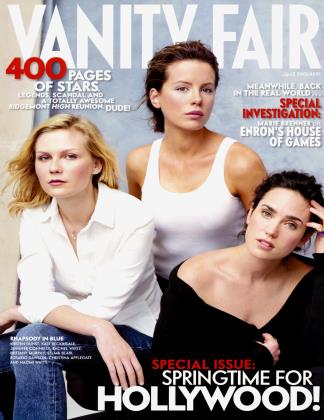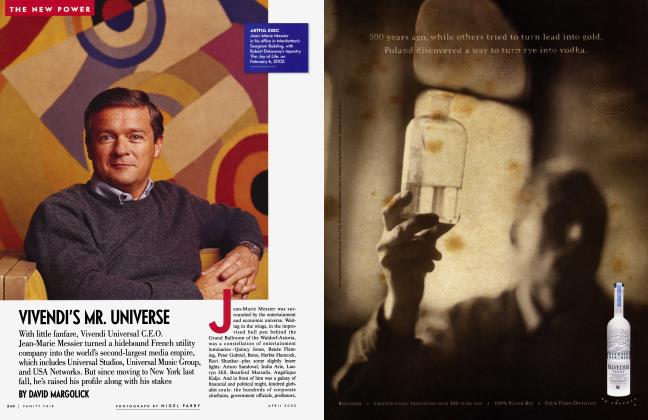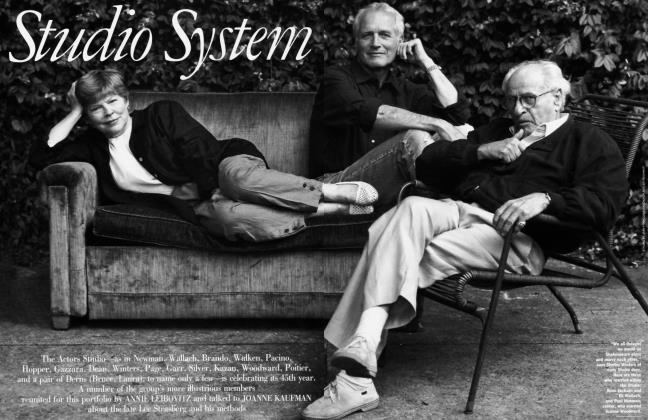Sign In to Your Account
Subscribers have complete access to the archive.
Sign In Not a Subscriber?Join NowAmerica's master paparazzo, RON GALELLA was willing to do almost anything to catch the famous unawares, and his tactics—especially with his most legendary victim, JACQUELINE KENNEDY ONASSIS—brought him a fame of his own. To mark the publication of a book of Galella's images, designer and fashion innovator TOM FORD reviews the way a notoriously pesky photographer helped create icons, redefine glamour, and launch the age of modern celebrity.
April 2002 Tom FordAmerica's master paparazzo, RON GALELLA was willing to do almost anything to catch the famous unawares, and his tactics—especially with his most legendary victim, JACQUELINE KENNEDY ONASSIS—brought him a fame of his own. To mark the publication of a book of Galella's images, designer and fashion innovator TOM FORD reviews the way a notoriously pesky photographer helped create icons, redefine glamour, and launch the age of modern celebrity.
April 2002 Tom Ford
As a child growing up in the 70s—and as a child obsessed with all things glamorous—I was familiar with Ron Galella’s images. I was also familiar with the scandals that often surrounded them and with his almost stalker tactics.
In his effort to capture the candid spirit of celebrity, Galella was an opportunist and a daredevil. Throughout the 60s, 70s, and early 80s, he roamed the streets of New York, Hollywood, and Las Vegas armed with a Nikon, an eagle eye, and endless bravado. Depending on their moods, the most famous stars in the world would adore him, curse him, or simply run in the opposite direction. They might douse him with water, as Brigitte Bardot did, or, as in the case of Marlon Brando, punch him in the jaw on a Chinatown street.
But he always got the shot. And I, like millions of others, often lived vicariously through his pictures. Scandal, romance, personality, and adventure always leapt from the surface of his portraits.
This, of course, is the goal of paparazzi photography: it freezes movement and, in so doing, captures character. Galella always caught his subjects in mid-action—Raquel Welch leaving a restaurant, Robert Redford hailing a cab, Ali MacGraw and Bob Evans enduring a customs check at the airport. He never gave them time to pose, and he certainly never asked for a publicist’s approval. He was a master of surprise. He was after the real emotions and genuine reactions that can only be seen in an outtake.
The images Galella captured in the throwaway moments between the main events often became iconic. It is the spontaneity of these photographs, the fact that his subjects were caught off guard in an instant of life, that makes them timeless and yet so much about their time. They are not slick, stylized images created by a marketing machine, nor are they “styled” as everything is today. They are raw, real, and they tell us more about each subject than he or she might have liked.
For better and for worse, Galella helped pioneer the culture of celebrity-watching as we now know it. He worked in a time before fame had become the tightly controlled industry that it is today, and was among the first American photographers to cross the line between the stars and their public. As a professional voyeur, Galella used methods that were invasive and controversial. Some called it tenacity, others obsession. Between 1969 and 1971, the peak of his “Jackie-tracking” years, Galella devoted half his time to charting Jackie Onassis’s whereabouts and taking her picture—until finally Onassis battled him in court for harassment.
Excerpted from The Photographs of Ron Galella, to be published this month by Greybull Press; photographs © by Ron Galella.
HE NEVER GAVE THEM TIME TO POSE... NEVER ASKED FOR PUBLICIST'S APPROVAL HE WAS A MASTER OF SURPRISE.
Ironically, the very photographs that Mrs. Onassis resisted were the ones that defined her as an icon. And the judge’s ruling—that Galella stay 25 feet away from her at all times—only contributed to her myth. It was the grainy black-and-white shots taken through a telephoto lens, the sequences of her playing with her children in Central Park, that turned the former Jacqueline Kennedy into the mysterious Jackie O. Wearing her signature dark glasses, she was constantly moving away. And she became all the more beautiful because she was perpetually out of reach. Much of what we came to love about Jackie we discovered through Galella’s candid images. Thirty years later, they continue to have a mystique that no formal studio portrait can match.
And as for Galella, the Onassis controversy only fueled the fire of his success. Though he tried unsuccessfully to countersue Jackie for damage to his livelihood, Galella ultimately benefited from the trial. It was featured on the cover of Life and made him a celebrity in his own right—if not as famous as the people he photographed, then, at the very least, notorious. He became the celebrity who shot celebrities. That was his edge. Graced with a larger-than-life presence, he got his “genuine reactions” by eliciting recognition from his subjects—eyes bulging with irritation, hands held up dramatically against the pop of his flash, or, sometimes, smiles and cleavage turned up to full wattage for his camera. It was Galella’s notoriety that gave his images their enduring power.
As a fashion designer, I have been influenced by Galella’s photographs throughout my career. He photographed the icons I grew up admiring and envying, and they were stamped on my imagination at an early age. I have frequently drawn upon my own mental archive of his images. Now I have come to realize that what enthralled me as a child still enthralls me today: there’s a brazen confidence to these icons, as if they were too busy living to notice that the eyes of the world were fixed upon them. And I can’t help but regret the predictable formula that constrains the celebrity photographs of today. The naked flash of spirit and the split-second authenticity that define Galella’s portraits are relics of a bygone age. These days, if an actor is photographed with his hair disheveled, looking for all the world like he’s woken up on the morning after, chances are it’s just good art direction.
THE NAKED FLASH OF SPIRIT AND THE DEFINE GALELLA'S PORTRAITS ARE RELICS OF SPLIT-SECOND AUTHENTICITY THAT BBA BYGONE AGE.... THEY ARE RAW, REAL.
 View Full Issue
View Full Issue












Subscribers have complete access to the archive.
Sign In Not a Subscriber?Join Now